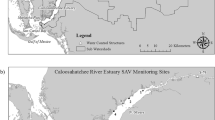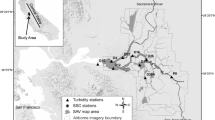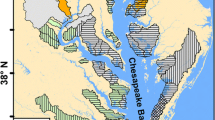Abstract
The loss of submerged aquatic vegetation (SAV) from the Patuxent estuary during the latter part of the 20th century was explored using diverse data sets that included historic SAV coverage and distribution data, SAV ground truth observations, water clarity and nutrient loading data, and epiphyte light attenuation measurements. Analysis of aerial photography from 1952 showed that SAV was abundant and widely distributed along the entire mesohaline region of the estuary; by the late 1960s rapid declines in SAV took place following large increases in nutrient loading to the estuary. An examination of water clarity and epiphyte data suggest that the processes that led to the loss of SAV varied in strength along the axis of the estuary. In the upper mesohaline region, Secchi depths were consistently less than established mesohaline SAV habitat requirements at 1-m water depth, suggesting that water clarity was responsible for SAV decline. In the lower mesohaline region, where water clarity was consistently above SAV requirements, high epiphyte fouling rates significantly reduced light available to SAV. Experimental results show that epiphyte fouling had the capacity to reduce available light to SAV blades from 30% to 7% of surface light within a week, and likely contributed to the local decline and near total loss of SAV during the late 1960s and early 1970s. The prognosis for near-term SAV recovery within the mesohaline portion of the estuary seems unlikely given existing water quality conditions.
Similar content being viewed by others
Literature Cited
Anderson, R. R. 1969. Temperature and rooted aquatic plants.Chesapeake Science 10:157–164.
Anderson, R. R., R. G. Brown, andR. D. Rappleye. 1968. Water quality and plant distribution along the upper Patuxent River, Maryland.Chesapeake Science 9:145–156.
Batuik, R., P. Bergstrom, M. Kemp, E. Koch, L. Murray, C. Stevenson, R. Bartleson, V. Carter, N. Rybicki, J. Landwehr, C. Gallegos, L. Karrh, M. Naylor, D. Wilcox, K. Moore, S. Ailstock, andM. Teichberg. 2000. Chesapeake Bay submerged aquatic vegetation water quality and habitatbased requirements and restoration targets: A second technical synthesis, CBP/TRS 245/00. EPA 903-R-00-014, U.S. Environmental Protection Agency, Chesapeake Bay Program, Annapolis, Maryland.
Borum, J. 1985. Development of epiphytic communities on eelgrass (Zostera marina) along a nutrient gradient in a Danish estuary.Marine Biology 87:211–218.
Brush, G. S. andF. W. Davis. 1984. Stratiographic Evidence of human disturbance in an estuary.Quaternary Research 22:91–108.
Brush, G. S. andW. B. Hilgartner. 2000. Paleoecology of submerged macrophytes in the upper Chesapeake Bay.Ecological Monographs 70:645–667.
Burt, J. S., G. A. Kendrock, R. J. Masini, andC. J. Simpson. 1995. Light andPosidonia sinuosa seagrass meadows in the temperate coastal waters of Western Australia: II. Effect of epiphyte species assemblage and biomass, on attenuating light to the leaf surface. Technical Series 62. Deparmtent of Environmental Protection. Perth, Western Australia.
Cambridge, M. L. andA. J. McComb. 1984. The loss of seagrasses in Cockburn sound, Western Australia. I. The time course and magnitude of seagrass decline in relation to industrial development.Aquatic Botany 20:229–243.
Costanza, R., H. C. Fitz, T. Maxwell, A. Voinov, H. Voinov, andL. A. Wainger. 1995. Patuxent Landscape Model: Sensitivity analysis and nutrient management scenarios. Interim report for U.S. EPA Cooperative Agreement: #CR 821925010. Center for Environmental and Estuarine Studies, University of Maryland, Solomons, Maryland.
Den Hartog, C. andP. J. G. Polderman. 1975. Changes in the seagrass populations of the Dutch Waddenzee.Aquatic Botany 1:141–147.
Dennison, W. C. andR. S. Albert. 1986. Photoadaptation and growth ofZostera marina L. (eelgrass) transplants along a depth gradient.Journal of Experimental Marine Biology and Ecology 98:265–282.
Domotor, D. K., M. S. Haire, N. N. Panday, andR. M. Summers. 1989. Patuxent estuary water quality assessment: Special emphasis 1983–1987. Technical Report No. 104. Maryland Department of the Environment Water Management Administration, Annapolis, Maryland.
Duarte, C. M. 1995. Submerged aquatic vegetation in relation to different nutrient regimes.Ophelia 41:287–112.
Duarte, C. M. 1999. Seagrass ecology at the turn of the millennium: Challenges for the new century.Aquatic Botany 65:7–20.
Hagy, J. D., W. R. Boynton, andM. M. Weir. 1998. Estimating nitrogen and phosphorus loads for Patuxent River, 1960–1977, p. 184–211.In W. R. Boynton and F. M. Rohland (eds.), Ecosystem Processes Component level 1. Interpretive Report No. 15. [UMCES]CBL 98-073a. Chesapeake Biological Laboratory, Solomons, Maryland.
Hagy, J. D., L. P. Sanford, andW. R. Boynton. 2000. Estimation of net physical transport and hydraulic residence times for a coastal plain estuary using box models.Estuaries 23:328–340.
Hungerford, J. 1859. The Old Plantation. Harper Bros. New York.
Kemp, W. M., W. R. Boynton, J. C. Stevenson, R. R. Twilley, andJ. C. Means. 1983. The decline of submerged vascular plants in upper Chesapeake Bay: Summary of results concerning possible causes.Marine Technology Society Journal 17: 78–89.
Maryland Office of State Planning. 2000. The Patuxent River Watershed: Atlas of Resource and Education. Chesapeake Bay Laboratory, Solomons, Maryland.
Moore, K. A., D. J. Wilcox, andR. J. Orth. 2000. Analysis of the coverage of submerged aquatic vegetation communities in the Chesapeake Bay.Estuaries 23:115–127.
Nash, C. B. 1947. Environmental characteristics of a river estuary.Journal of Marine Research 6:147–174.
Newcomb, C. L. andH. F. Brust. 1946. Variations in the phosphorus contents of estuarine water of the Chesapeake Bay—Near Solomons Island, Md.Journal of Marien Research 3:76–88.
Orth, R. J. andK. A. Moore. 1983. Chesapeake Bay: An unprecedented decline in submerged aquatic vegetation.Science 222:51–53.
Orth, R. J. andK. A. Moore. 1984. Distribution and coverage of submerged aquatic vegetation in Chesapeake Bay: An historical perspective.Estuaries 7:531–540.
Phillips, G. L., D. Eminson, andB. Moss. 1978. A mechanism to account for macrophyte decline in progressively eutrophicated freshwaters.Aquatic Botany 4:103–126.
Stankelis, R. M., W. R. Boynton, andJ. M. Frank. 1999. Submerged aquatic vegetation (SAV) habitat evaluation, p. 77–117.In W. R. Boynton and F. M. Rohland (eds.), Ecosystem Processes Component Level 1. Interpretive Report No. 16. Chesapeake Biological Laboratory, Solomons, Maryland.
Sweeney, B. F. 1995. Community metabolism in the Patuxent River estuary: 1963–1969 and 1992. Masters Thesis, University of Maryland, Solomons, Maryland.
Twilley, R. R., W. M. Kemp, K. W. Staver, J. C. Stevenson, andW. R. Boynton. 1985. Nutrient enrichment of esturine submerged vascular plant communities. 1. Algal growth and effects on production of plants and associated communities.Marine Ecology Progress Series 23:179–191.
Wetzel, R. G. andR. A. Hough. 1973. Productivity and role of aquatic macrophytes in lakes: An assessment.Polish Archives of Hydrobiology 20:9–19.
Author information
Authors and Affiliations
Corresponding author
Rights and permissions
About this article
Cite this article
Stankelis, R.M., Naylor, M.D. & Boynton, W.R. Sumberged aquatic vegetation in the mesohaline region of the Patuxent estuary: Past, present, and future status. Estuaries 26, 186–195 (2003). https://doi.org/10.1007/BF02695961
Received:
Revised:
Accepted:
Issue Date:
DOI: https://doi.org/10.1007/BF02695961




